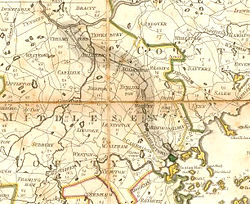Middlesex Canal
|
Middlesex Canal
|
|

Remnants of the aqueduct that carried the canal over the Shawsheen River on the Billerica-Wilmington town line
|
|
| Location | Lowell-Woburn, Massachusetts (surviving fragments) |
|---|---|
| Area | 245 acres (99 ha) |
| Built | 1803 |
| Architect | Loammi Baldwin; James Sullivan |
| NRHP Reference # | 72000117 |
| Added to NRHP | August 21, 1972 |
|
Middlesex Canal Historic and Archeological District
|
|

Map of the Middlesex Canal, 1801, before it was extended south of Medford.
|
|
| Location | The entire route of the canal from Lowell to Charlestown. |
|---|---|
| Area | 253 acres (102 ha) |
| Built | 1803 |
| NRHP Reference # | 09000936 |
| Added to NRHP | November 19, 2009 |
The Middlesex Canal was a 27-mile (44-kilometer) barge canal connecting the Merrimack River with the port of Boston. When operational it was 30 feet (9.1 m) wide, and 3 feet (0.9 m) deep, with 20 locks, each 80 feet (24 m) long and between 10 and 11 feet (3.0 and 3.4 m) wide. It also had 8 aqueducts.
The canal was one of the first civil engineering projects of its type in the United States, and was studied by engineers working on other major canal projects such as the Erie Canal. A number of innovations made the canal possible, including hydraulic cement, which was used to mortar its locks, and an ingenious floating towpath to span the Concord River.
By 1790, England had thirty years experience and all of continental Europe's many canals to draw on for experience. In the years following the American Revolutionary War, the young United States began a period of economic expansion away from the coast. American men of influence had always kept an eye on news from Europe, especially that from Great Britain, so when in the four years 1790-1794 the British Parliament passed no less than eighty-one canal and navigation acts, American leaders were paying attention.
Because of extremely poor roads, the cost of bringing goods such as lumber, ashes, grain, and fur to the coast could be quite high if water transport could not be utilized. Most of American rivers were infested with rapids and waterfalls, rendering boating navigation even more of a challenge. Up and down the Atlantic coast, companies were formed to develop canals as comparatively inexpensive means to bring goods from the interior of the country to the coast, and to send imported goods into the interior. Well aware that to stay independent the nation needed to grow strong and develop industries, the news from Europe rekindled a number of dropped canal or navigations projects and began discussions leading in the next decades to many others. The year of 1790 is created as the start of the American Canal Age.
...
Wikipedia


